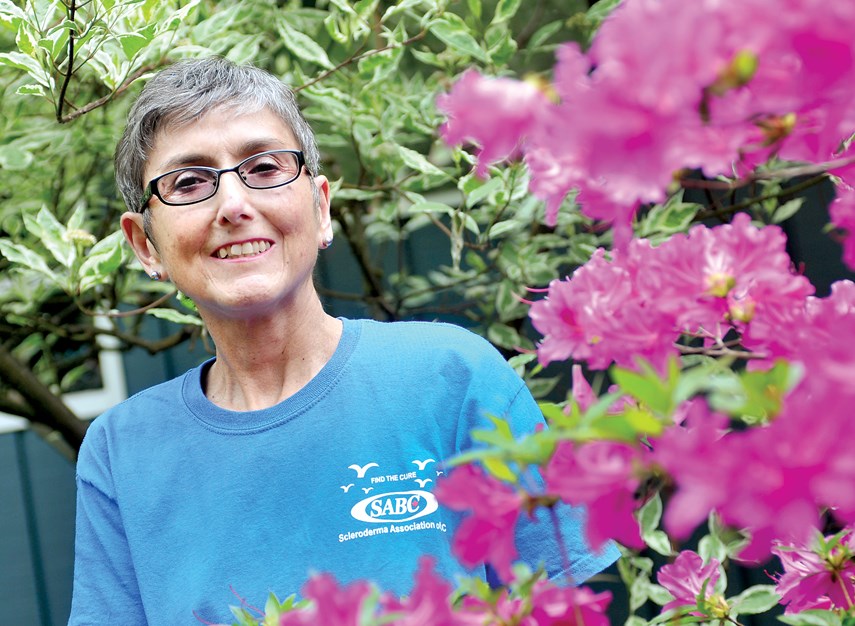Some days Rosanne Queen has trouble swallowing due to her illness. But right now she’s content to speak up.
“When I look at the scleroderma community, I have never been around so many positive people who are sick,” explains the longtime North Vancouver resident and president of the Scleroderma Association of BC.
“We all should be enjoying life and doing what we want to do because we don’t know what tomorrow will bring. I feel that I’m really, really lucky,” she says.
Queen is getting the word out about the association’s upcoming fourth annual Scotiabank Hot Dog Day being held at Lonsdale Avenue and 14th Street on June 1, an event intended to raise awareness and fund research for the rare autoimmune disease.
It was 1992, Queen explains, when she went up Grouse Mountain for a day of skiing only to pull her thumb from her mitt and observe it had turned completely white.
“I just assumed I had frost bite,” she says.
She didn’t. She was diagnosed with Raynaud’s phenomenon, a rare blood vessel disorder that usually affects a person’s fingers and toes and is often a prelude to scleroderma.
Scleroderma affects individuals differently, but is most commonly described as a hardening of one’s connective tissue.
“The skin can become like concrete,” Queen says. “It hardens the arteries, it hardens the blood vessels, and it hardens around the organs. They believe we build up too much collagen and they don’t know how or why, or how to stop it.”
Five years after first being diagnosed with Raynaud’s, Queen says she was experiencing a particularly unpleasant bout of swollen hands and a thickening of the skin on her thumb when a doctor said she had developed scleroderma.
She was unfamiliar with the disease, but after receiving her diagnosis she got into her car and started to cry. What causes scleroderma is still unknown and, at this point, there’s no cure for the disease.
It affects less than 16,000 people across Canada, Queen says, adding that some people die within six months of being diagnosed while others go on to lead long and fulfilling lives.
“Twenty years later, I’m still doing OK. We still travel. And it’s become a real priority – the work-balance and the health-balance – because we’re working to play and to have a really good life and have fun,” she says.
But that’s not all. She says her disease has made her want to work harder to educate people about scleroderma and help those that feel alone with their illness.
She became the president of the Scleroderma Association of BC four years ago in order to provide a voice to those that have the disease and to help raise money, including funding for a genome research study.
“What they’re trying to do at St. Paul’s Hospital is they’ve taken 15 scleroderma and non-scleroderma patients and they’re trying to find the difference,” she explains.
“What’s different between our blood and your blood?”
In 2012, Queen and her husband started the annual Scleroderma Ride for Research, a 30-kilometre bicycle ride up to UBC and through the city and around the Vancouver seawall that to date has raised more than $165,000 for scleroderma research. Queen rides a tandem bike when a flare up makes gripping a bicycle’s handlebar an impossibility. This year’s ride is scheduled for June 17.
When talking about her disease, Queen is frank about the challenges the hardening of her connective tissue have caused her. She says swallowing is particularly hard these days due to her esophagus losing much of its elasticity, which has also resulted in severe acid reflux and ensured that she has to eat in a very slow, methodical manner.
“When you’re eating socially, I’m always the very last one. It takes me forever to eat,” she says, adding that other ailments that have come up as a result of her disease include very tight and thick skin, rheumatoid arthritis, restricted wrist movement, curled fingers, and interstitial lung disease.
She remains optimistic for herself and for the others that live with scleroderma.
“The last month or so I’ve been in a lot of pain with my hands and as weird as this sounds, I still feel lucky,” she stated in an email later on. “I can look around and see others in more pain and discomfort than I am and they still have a smile on their face. Easy to follow their lead about being positive!”
More information about the association and its upcoming events, such as the Scotiabank Hot Dog Day and Scleroderma Ride for Research, can be found by visiting sclerodermabc.ca.



